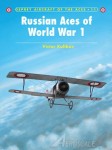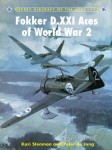1⁄1
Tuesday, January 15, 2013 - 06:31 AM UTC
Here is a quick preview of the latest books announced by Osprey Publishing. Three different eras are represented this time, from "spruce and linen" machines to the loud and fast jets.
Russian Aces of World War 1
Aircraft of the Aces 111
Author: Victor Kulikov
Illustrator: Harry Dempsey
Paperback;
April 2013
Pages: 96
ISBN: 9781780960593
About this book (according to Osprey)
Although the Russian Imperial Army Air Service consisted of no more than four BAGs (Boevaya Aviatsionniy Gruppa – battle aviation groups), each controlling three or four smaller AOIs (Aviatsionniy Otryad Istrebitelei – fighter aviation detachments) equipped with a variety of aircraft types, its fighter pilots nevertheless gave a good account of themselves. Indeed, during three years of war they claimed more than 200 Austro-Hungarian and German aircraft shot down, creating 13 aces – these elite aviators accounted for around half of the victories claimed on the Eastern Front. Pilots flew a variety of fighter types, with French Nieuport scouts and SPAD VIIs proving to be the most popular, and effective, aeroplanes to see service on this front. The exploits of these aces are detailed here, with information based on material newly sourced by the author from Russian military and private archives. Many previously unpublished photographs are used to illustrate this book, supported by full-colour profiles that reveal how striking some of the aces’ fighters were in this often-forgotten theatre of World War I.
Contents
Fokker D.XXI Aces of World War 2
Aircraft of the Aces 112
Authors: Kari Stenman Peter de Jong
Illustrators: Chris Davey Mark Postlethwaite
Paperback
April 2013
Pages: 96
ISBN: 9781780960623
About this book (according to Osprey)
The Dutch D.XXIs saw less than a week of action following the German invasion of the west on 10 May 1940, with many of the country’s 28 fighters being destroyed on the ground. However, those that survived the initial onslaught inflicted losses on the Luftwaffe. By then, however, the D.XXI had found everlasting fame in Finland during the Winter War of 1939-40. Proving itself a real thorn in the side of the Soviets, the fighter, operating in primitive conditions and against vastly superior numbers, Finnish D.XXIs racked up an incredible score against the Red Air Force. The D.XXI also has the distinction of producing the first ‘ace in a single mission’ in World War 2, when then 1Lt Jorma Sarvanto shot down six Ilyushin DB-3 bombers on 6 January 1940. After spending a year providing home defence and flying coastal patrols during the early stages of the Continuation War in 1941, all surviving Finnish Fokker D.XXIs were relegated to the reconnaissance role, which they performed through to the end of hostilities in September 1944.
Contents
USAF McDonnell Douglas F-4 Phantom II
Air Vanguard 7
Author: Peter Davies
Illustrators: Henry Morshead Adam Tooby
Paperback
April 2013
Pages: 64
ISBN: 9781780966083
About this book (according to Osprey)
In many respects the most successful, versatile and widely-used combat aircraft of the post-war era the F-4 Phantom II was quickly adopted by the USAF after its spectacular US Navy introduction. Its introduction to USAF squadrons happened just in time for the Vietnam conflict where USAF F-4Cs took over MiG-fighting duties from the F-100 Super Sabre. Although the F-4 was never intended as a dog-fighter to tangle with light, nimble, gun-armed MiGs it was responsible for destroying 109 MiGs in aerial combat. At the end of their careers many of the survivors from the 3,380 ‘land-based’ Phantoms were converted into target drones for training purposes. New aircraft were also built for West Germany, Iran and Israel. The USAF’s experience with the Phantom showed clearly that the air-to-air fighter was still a necessity and its decision to fund its successor, the McDonnell-Douglas F-15 Eagle (as well as the F-16 Fighting Falcon and F-22A Raptor) was heavily influenced by the lessons of US and other Phantom pilots in combat.
Contents
Please remember, when contacting retailers or manufacturers, to mention that you saw their products highlighted here - on AEROSCALE.
Aircraft of the Aces 111
Author: Victor Kulikov
Illustrator: Harry Dempsey
Paperback;
April 2013
Pages: 96
ISBN: 9781780960593
About this book (according to Osprey)
Although the Russian Imperial Army Air Service consisted of no more than four BAGs (Boevaya Aviatsionniy Gruppa – battle aviation groups), each controlling three or four smaller AOIs (Aviatsionniy Otryad Istrebitelei – fighter aviation detachments) equipped with a variety of aircraft types, its fighter pilots nevertheless gave a good account of themselves. Indeed, during three years of war they claimed more than 200 Austro-Hungarian and German aircraft shot down, creating 13 aces – these elite aviators accounted for around half of the victories claimed on the Eastern Front. Pilots flew a variety of fighter types, with French Nieuport scouts and SPAD VIIs proving to be the most popular, and effective, aeroplanes to see service on this front. The exploits of these aces are detailed here, with information based on material newly sourced by the author from Russian military and private archives. Many previously unpublished photographs are used to illustrate this book, supported by full-colour profiles that reveal how striking some of the aces’ fighters were in this often-forgotten theatre of World War I.
Contents
- Introduction
- Aces of the 1st Fighting Air Group
- Aces of the 7th Fighter Squadron
- Aces of the 9th Fighter Squadron
- Aces of other fighter squadrons and Fighting Air Groups
- Naval Aces
- Russian aces in French aviation
- Appendix
- Plates Commentaries
Fokker D.XXI Aces of World War 2
Aircraft of the Aces 112
Authors: Kari Stenman Peter de Jong
Illustrators: Chris Davey Mark Postlethwaite
Paperback
April 2013
Pages: 96
ISBN: 9781780960623
About this book (according to Osprey)
The Dutch D.XXIs saw less than a week of action following the German invasion of the west on 10 May 1940, with many of the country’s 28 fighters being destroyed on the ground. However, those that survived the initial onslaught inflicted losses on the Luftwaffe. By then, however, the D.XXI had found everlasting fame in Finland during the Winter War of 1939-40. Proving itself a real thorn in the side of the Soviets, the fighter, operating in primitive conditions and against vastly superior numbers, Finnish D.XXIs racked up an incredible score against the Red Air Force. The D.XXI also has the distinction of producing the first ‘ace in a single mission’ in World War 2, when then 1Lt Jorma Sarvanto shot down six Ilyushin DB-3 bombers on 6 January 1940. After spending a year providing home defence and flying coastal patrols during the early stages of the Continuation War in 1941, all surviving Finnish Fokker D.XXIs were relegated to the reconnaissance role, which they performed through to the end of hostilities in September 1944.
Contents
- Chapter 1 Fokker for exports
- Chapter 2 Winter War
- Chapter 3 Weserübung
- Chapter 4 Obsolescence
- APPENDICES
USAF McDonnell Douglas F-4 Phantom II
Air Vanguard 7
Author: Peter Davies
Illustrators: Henry Morshead Adam Tooby
Paperback
April 2013
Pages: 64
ISBN: 9781780966083
About this book (according to Osprey)
In many respects the most successful, versatile and widely-used combat aircraft of the post-war era the F-4 Phantom II was quickly adopted by the USAF after its spectacular US Navy introduction. Its introduction to USAF squadrons happened just in time for the Vietnam conflict where USAF F-4Cs took over MiG-fighting duties from the F-100 Super Sabre. Although the F-4 was never intended as a dog-fighter to tangle with light, nimble, gun-armed MiGs it was responsible for destroying 109 MiGs in aerial combat. At the end of their careers many of the survivors from the 3,380 ‘land-based’ Phantoms were converted into target drones for training purposes. New aircraft were also built for West Germany, Iran and Israel. The USAF’s experience with the Phantom showed clearly that the air-to-air fighter was still a necessity and its decision to fund its successor, the McDonnell-Douglas F-15 Eagle (as well as the F-16 Fighting Falcon and F-22A Raptor) was heavily influenced by the lessons of US and other Phantom pilots in combat.
Contents
- Introduction
- Design and Development
- Technical Specifications and Variants
- Operational History
- Conclusion
- Bibliography and Further Reading
Please remember, when contacting retailers or manufacturers, to mention that you saw their products highlighted here - on AEROSCALE.
Click Star to Rate
Only 1 reader has rated this.
THIS STORY HAS BEEN READ 7,731 TIMES.
| Osprey Publishing Reviews | MORE |
| P-47 vs Ki-43 by Frederick Boucher | |
| P-40E Warhawk vs A6M2 Zero-Sen by Frederick Boucher | |
| Guadalcanal 1942-43 by Frederick Boucher | of 1 ratings, 100% found this helpful | |
| Ploesti 1943 by Frederick Boucher | of 1 ratings, 100% found this helpful | |
| Schweinfurt–Regensburg 1943 by Frederick Boucher | of 1 ratings, 100% found this helpful | |
| Do 17 Units of World War 2 by Frederick Boucher | of 1 ratings, 100% found this helpful | |
| Six-Day War 1967 by Michael Satin | of 2 ratings, 100% found this helpful | |
| F-105 vs MiG-17 by Frederick Boucher | of 1 ratings, 100% found this helpful | |
| XB-70 Valkyrie by Frederick Boucher | of 1 ratings, 100% found this helpful | |
| Zero Aces 1940-42 by Frederick Boucher | of 2 ratings, 100% found this helpful | |
| Spitfire VC vs A6M Zero by Frederick Boucher | of 1 ratings, 100% found this helpful | |
| Linebacker II by Frederick Boucher | of 1 ratings, 100% found this helpful | |
| CBI B-25 Units by Frederick Boucher | of 1 ratings, 100% found this helpful | |
| Hellcat vs Shiden by Frederick Boucher | |
| Air Combat Dogfights WWII by Frederick Boucher | of 1 ratings, 100% found this helpful | |












Comments